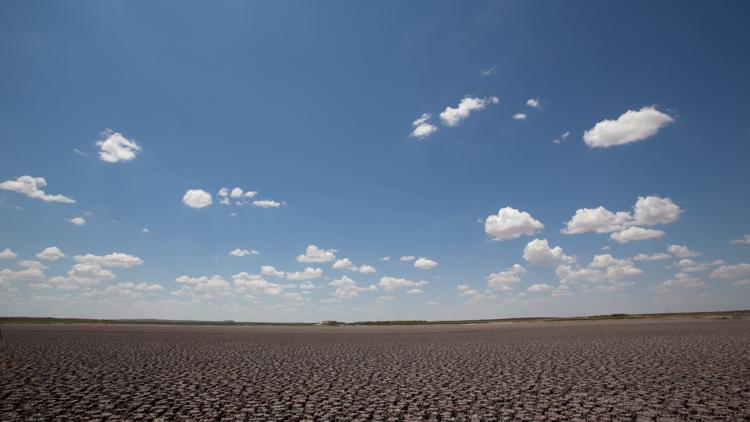SNYDER, Texas — At 10:38 p.m. Monday, the ground began to rumble in West Texas.
The real action was nearly five miles below the surface, where a 4.9-magnitude earthquake happened just west of the Scurry-Fisher county line. A few minutes later, and several miles to the northwest, another earthquake rumbled -- this time a 2.8-magnitude rattler. Three more earthquakes then followed in the same area, all within the same half-hour, according to data from U.S. Geological Survey.
Rumblings -- most likely from the initial 4.9-magnitude earthquake, about 10 miles northwest of Hermleigh -- were felt across the West Texas region, and reportedly as far away as the Dallas-Fort Worth metroplex, about three hours to the east.
Four days later, on Friday, a 5.1-magnitude earthquake in the same area near Hermleigh was also reportedly felt as far away as North Texas.
The exact causes of the earthquakes won't be determined until researchers have the chance to look into them further. But they were all part of a recent cluster of earthquakes in the Hermleigh area this week, most of them in the smaller 1.0-2.0-magnitude range, according to USGS data.
More broadly, they were part of a growing trend in Texas in the last five years: Earthquakes are becoming increasingly common in the Lone Star State, particularly in West Texas.
In 2023, there were 2,493 earthquakes that registered a 2.0-magnitude or higher on the Richter scale in Texas, according to data compiled by the Bureau of Economic Geology at the University of Texas at Austin.
These numbers were similar to those of 2022 when Texas saw 2,601 earthquakes of at least a 2.0-magnitude.
But they are also more than double the amount in seen 2020, and eight times the amount in 2017 -- all according to the bureau, which tracks Texas earthquakes through the TexNet Earthquake Catalog.
This increase in earthquakes has been attributed by researchers to the rise of a form of oil drilling known as hydraulic fracturing, or fracking. The process involves injecting liquid into a well to break up shale and rock to extract oil or gas reserves, as the USGS explains here.
Often, the USGS says, it's not the fracking that causes the earthquakes but rather the disposing of the large amounts of wastewater it produces.
The disposal of that wastewater -- which sees it injected deep back into the earth's surface -- is what researchers have identified as the "primary causal agent" of the increased number of Texas earthquakes, said Dr. Peter H. Hennings, the principal investigator for the Bureau of Economic Geology's Center for Injection and Seismicity Research.
Hennings researches earthquakes and their causes and has authored numerous papers that detail the recent rise in earthquakes in Texas.
Hennings said the 4.9-magnitude earthquake near Hermleigh this week was "certainly notable." For one, Hennings said a 4.9 reading is on the higher end of what Texas usually sees, although the state has in recent years seen recordings venture past the 5.0 magnitudes.
He also notes that the Hermleigh earthquakes happened within a newer cluster of earthquakes recorded on the eastern shelf of the Midland Basin. It's just one of many clusters identified across the Midland Basin and Delaware Basin, and extending into New Mexico, according to research Hennings has compiled.
In a 2023 paper published by the Geological Society of America, Hennings and co-author Michael H. Young presented data that showed the sharp increase in earthquakes in the last five years.
While the North Texas area saw an increase in earthquakes about 10 years ago, most of the recent rise in earthquakes has been seen in the Delaware and Midland basins of West Texas, located along the Interstate 10 corridor between Odessa and El Paso.


Hennings said his research has shown a clear connection between fracking -- and specifically, the injecting of wastewater back into the surface -- and earthquakes. In an upcoming paper, Hennings and colleague Katie Smye showed the scope of the wastewater injections, saying around 45 billion barrels have needed to be disposed of since 2009.
"This injection has altered subsurface stress and caused the widespread development of earthquakes on preexisting faults," Hennings and Smye wrote.
Hennings' office has also found that, when the fracking and injections stop, the earthquakes tend to stop as well -- although change might not come immediately.
"Even if you stop injection, that pressure takes time to dissipate," Hennings said. "If you were to stop injection today, it doesn't mean the earthquakes will stop today... but they still stop."
Hennings said the last decade or so of earthquake activity in Texas has given researchers a clearer picture of the trend.
"We've learned a lot by watching these processes play out in Texas," Hennings said. "Now we see it very clearly. It's following what we expect. If the rates of injection increase, I would expect problematic earthquakes."



